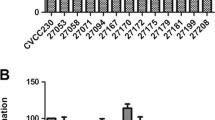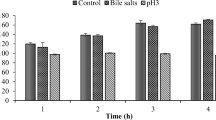Abstract
Nowadays, the bacteriocin industries have seen significant growth, supplanting chemical preservatives in its ability to improve the shelf-life and safety of food. The increasing customer desire to use natural preservatives has fueled advancing bacteriocin research. The objective of this study was to identify lactic acid bacteria (LAB) that produce bacteriocin-like inhibitory substance (BLIS) and have strong anti-listerial activity. We have identified and analyzed a LAB obtained from chhurpi samples, a popular milk-derived product in the Himalayan regions of India and Nepal. The strain was studied and identified based on its morphological, biochemical, and physiological characteristics. Furthermore, the molecular 16s-rDNA analysis suggests that the strain was Lactococcus sp. RGUAM1 (98.2% similar to Lactococcus lactis subsp. hordniae NBRC 100931T). The isolated strain can produce a potent BLIS, which has shown efficacy against three gram-positive bacteria responsible for food spoilage, such as Listeria monocytogenes (MTCC 657), Staphylococcus aureus subsp. aureus (MTCC 87), Lactobacillus plantarum (MTCC 1407), Lactobacillus paraplantarum (MTCC 12904). The scanning electron microscope (SEM) image illustrates that the crude cell-free supernatant (CFS) disrupts the cell envelope, leading to the release of cellular contents and the clustering of cells. In addition, this BLIS can easily withstand a wide range of pH (2–12), temperature (up to 100 °C for 15 min), bile salt (0.3% W/V), salinity (4% W/V), and enzyme activity of 1600 AU/ml against Listeria monocytogenes. Our research offers a robust framework and valuable insights into bio-preservation and its potential applications in diverse food products.





Similar content being viewed by others
References
Aljohani AB, Al-Hejin AM, Shori AB (2023) Bacteriocins as promising antimicrobial peptides, definition, classification, and their potential applications in cheeses. Food Sci Technol. https://doi.org/10.1590/fst.118021
Azhar NS, Zin NHM, Hamid THTA (2017) Lactococcus lactis strain a5 producing nisin-like bacteriocin active against gram positive and negative bacteria. Trop Life Sci Res 28(2):107
Bartenslager A (2020) Investigating microbiomes and developing direct-fed microbials to improve cattle health
Chatterjee M, Jana SC, Raychaudhuri U (2021) Isolation, purification and characterization of a bacteriocin with broad spectrum activity from Lactococcus lactis JC10 from perishable papaya fruit. J Microbiol Biotechnol Food Sci 2021:655–660
Chen J, Shen J, Ingvar Hellgren L, Ruhdal Jensen P, Solem C (2015) Adaptation of Lactococcus lactis to high growth temperature leads to a dramatic increase in acidification rate. Sci Rep 5(1):14199. https://doi.org/10.1038/srep14199
Chen L, Sun L, Zhang R, Liao N, Qi X, Chen J (2022) Surveillance for foodborne disease outbreaks in Zhejiang Province, China, 2015–2020. BMC Public Health 22(1):1–9
Cho Y, Han HT, Kim T-R, Sohn M, Park Y-S (2023) Immunostimulatory activity of Lactococcus lactis LM1185 isolated from Hydrangea macrophylla. Food Sci Biotechnol 32(4):497–506. https://doi.org/10.1007/s10068-022-01199-5
CLSI (2014) Performance standards for antimicrobial susceptibility testing 24th informational supplement. Clinical and Laboratory Standards Institute, Wayne
Colombo M, Castilho NP, Todorov SD, Nero LA (2018) Beneficial properties of lactic acid bacteria naturally present in dairy production. BMC Microbiol 18:1–12
Cossettini A, Vidic J, Maifreni M, Marino M, Pinamonti D, Manzano M (2022) Rapid detection of Listeria monocytogenes, Salmonella, Campylobacter spp., and Escherichia coli in food using biosensors. Food Control 137:108962
Darmastuti A, Hasan PN, Wikandari R, Utami T, Rahayu ES, Suroto DA (2021) Adhesion properties of Lactobacillus plantarum Dad-13 and Lactobacillus plantarum Mut-7 on Sprague Dawley rat intestine. Microorganisms 9(11):2336
De Vuyst L, Vandamme EJ (2012) Bacteriocins of lactic acid bacteria: microbiology, genetics and applications. Springer
Du H, Yang J, Lu X, Lu Z, Bie X, Zhao H, Zhang C, Lu F (2018) Purification, characterization, and mode of action of plantaricin GZ1-27, a novel bacteriocin against Bacillus cereus. J Agric Food Chem 66(18):4716–4724
FAO (2002) WHO working group report on drafting guidelines for the evaluation of probiotics in food. London Ontario Canada 30(1):16–22
FotsoTecheu UD, Kaktcham PM, Momo HK, FokoKouam EM, TchamaniPiame L, Ngouenam RJ, ZambouNgoufack F (2022) Isolation, characterization, and effect on biofilm formation of bacteriocin produced by Lactococcus lactis F01 isolated from Cyprinus carpio and application for biopreservation of fish sausage. Biomed Res Int 2022:8437926
Ghrairi T, Frere J, Berjeaud J, Manai M (2008) Purification and characterisation of bacteriocins produced by Enterococcus faecium from Tunisian rigouta cheese. Food Control 19(2):162–169
Huang K, Zeng J, Liu X, Jiang T, Wang J (2021) Structure of the mannose phosphotransferase system (man-PTS) complexed with microcin E492, a pore-forming bacteriocin. Cell Discovery 7(1):20
Jawan R, Abbasiliasi S, Mustafa S, Kapri MR, Halim M, Ariff AB (2021) In vitro evaluation of potential probiotic strain Lactococcus lactis Gh1 and its bacteriocin-like inhibitory substances for potential use in the food industry. Probiotics Antimicrob Proteins 13:422–440. https://doi.org/10.1007/s12602-020-09690-3
Kalhoro MS, Visessanguan W, Nguyen LT, Anal AK (2019) Probiotic potential of Lactobacillus paraplantarum BT-11 isolated from raw buffalo (Bubalus bubalis) milk and characterization of bacteriocin-like inhibitory substance produced. J Food Process Preserv 43(8):e14015
Kalhoro MS, Anal AK, Kalhoro DH, Hussain T, Murtaza G, Mangi MH (2023) Antimicrobial activities and biopreservation potential of Lactic Acid Bacteria (LAB) from Raw Buffalo (Bubalus bubalis) Milk. Oxid Med Cell Longev. https://doi.org/10.1155/2023/8475995
Khelissa S, Chihib N-E, Gharsallaoui A (2021) Conditions of nisin production by Lactococcus lactis subsp. lactis and its main uses as a food preservative. Arch Microbiol 203:465–480. https://doi.org/10.1007/s00203-020-02054-z
Kim T, Mondal SC, Jeong CR, Kim SR, Ban OH, Jung YH, Yang J, Kim SJ (2022) Safety evaluation of Lactococcus lactis IDCC 2301 isolated from homemade cheese. Food Sci Nutr 10(1):67–74. https://doi.org/10.1002/fsn3.2648
Krausova G, Hyrslova I, Hynstova I (2019) In vitro evaluation of adhesion capacity, hydrophobicity, and auto-aggregation of newly isolated potential probiotic strains. Fermentation 5(4):100. https://doi.org/10.3390/fermentation5040100
Kumar A, Kumar D (2015) Characterization of Lactobacillus isolated from dairy samples for probiotic properties. Anaerobe 33:117–123. https://doi.org/10.1016/j.anaerobe.2015.03.004
Manna A, Mondal R (2023) Bacteriocin-mediated food preservation in conjugation with silver nanoparticles: a green approach. Food Chem Adv. https://doi.org/10.1016/j.focha.2023.100464
Mohammad A-M, Chowdhury T, Biswas B, Absar N (2018) Food poisoning and intoxication: a global leading concern for human health. Food safety and preservation. Elsevier, Amsterdam, pp 307–352
Morel CM, Lindahl O, Harbarth S, de Kraker ME, Edwards S, Hollis A (2020) Industry incentives and antibiotic resistance: an introduction to the antibiotic susceptibility bonus. J Antibiot 73(7):421–428. https://doi.org/10.1038/s41429-020-0300-y
Navale VD, Borade BR, Rama Krishna G, Vamkudoth KR, Kontham R (2023) Metabolites from Lactococcus lactis subsp. lactis: Isolation, structure elucidation, and antimicrobial activity. ACS Omega 8:36628–36635
Nielsen JW, Dickson JS, Crouse JD (1990) Use of a bacteriocin produced by Pediococcus acidilactici to inhibit Listeria monocytogenes associated with fresh meat. Appl Environ Microbiol 56(7):2142–2145. https://doi.org/10.1128/aem.56.7.2142-2145.1990
Park D (2007) Genomic DNA isolation from different biological materials. Protocol Nucleic Acid Anal Nonradioact Probes. https://doi.org/10.1385/1-59745-229-7:3
Parveen Rani R, Anandharaj M, Hema S, Deepika R, David Ravindran A (2016) Purification of antilisterial peptide (Subtilosin A) from novel bacillus tequilensis FR9 and demonstrate their pathogen invasion protection ability using human carcinoma cell line. Front Microbiol 7:1910
Pérez-Ramos A, Madi-Moussa D, Coucheney F, Drider D (2021) Current knowledge of the mode of action and immunity mechanisms of LAB-bacteriocins. Microorganisms 9(10):2107. https://doi.org/10.3390/microorganisms9102107
Phillips MC (2022) Metabolic strategies in healthcare: a new era. Aging Dis 13(3):655. https://doi.org/10.14336/AD.2021.1018
Powell J, Witthuhn R, Todorov S, Dicks L (2007) Characterization of bacteriocin ST8KF produced by a kefir isolate Lactobacillus plantarum ST8KF. Int Dairy J 17(3):190–198. https://doi.org/10.1016/j.idairyj.2006.02.012
Ramalho JB, Soares MB, Spiazzi CC, Bicca DF, Soares VM, Pereira JG, Da Silva WP, Sehn CP, Cibin FW (2019) In vitro probiotic and antioxidant potential of Lactococcus lactis subsp. cremoris LL95 and its effect in mice behaviour. Nutrients 11(4):901
Ripamonti B, Agazzi A, Bersani C, De Dea P, Pecorini C, Pirani S, Rebucci R, Savoini G, Stella S, Stenico A (2011) Screening of species-specific lactic acid bacteria for veal calves multi-strain probiotic adjuncts. Anaerobe 17(3):97–105. https://doi.org/10.1016/j.anaerobe.2011.05.001
Shafique B, Ranjha MMAN, Murtaza MA, Walayat N, Nawaz A, Khalid W, Mahmood S, Nadeem M, Manzoor MF, Ameer K (2022) Recent trends and applications of nanoencapsulated bacteriocins against microbes in food quality and safety. Microorganisms 11(1):85. https://doi.org/10.3390/microorganisms11010085
Sharma R, Garg P, Kumar P, Bhatia SK, Kulshrestha S (2020) Microbial fermentation and its role in quality improvement of fermented foods. Fermentation 6(4):106. https://doi.org/10.3390/fermentation6040106
Sharma K, Kaur S, Singh R, Kumar N (2021) Classification and mechanism of bacteriocin induced cell death: a review: bacteriocin classification and their mode action. J Microbiol Biotechnol Food Sci 11(3):e3733–e3733. https://doi.org/10.15414/jmbfs.3733
Some S, Sarkar B, Biswas K, Jana TK, Bhattacharjya D, Dam P, Mondal R, Kumar A, Deb AK, Sadat A (2020) Bio-molecule functionalized rapid one-pot green synthesis of silver nanoparticles and their efficacy toward the multidrug resistant (MDR) gut bacteria of silkworms (Bombyx mori). RSC Adv 10(38):22742–22757. https://doi.org/10.1039/D0RA03451G
Song M, Yun B, Moon J-H, Park D-J, Lim K, Oh S (2015) Characterization of selected Lactobacillus strains for use as probiotics. Korean J Food Sci Anim Resour 35(4):551. https://doi.org/10.5851/kosfa.2015.35.4.551
Subair H (2015) Isolation and Screening Bacterial Exopolysaccharide (EPS) from potato rhizosphere in highland and the potential as a producer Indole Acetic Acid (IAA). Procedia Food Sci 3:74–81. https://doi.org/10.1016/j.profoo.2015.01.007
Vanniyasingam J, Kapilan R, Vasantharuba S (2019) Isolation and characterization of potential probiotic lactic acid bacteria isolated from cow milk and milk products. AGRIEAST. https://doi.org/10.4038/agrieast.v13i1.62
Xu Y, Tian Y, Cao Y, Li J, Guo H, Su Y, Tian Y, Wang C, Wang T, Zhang L (2019) Probiotic properties of Lactobacillus paracasei subsp. paracasei L1 and its growth performance-promotion in chicken by improving the intestinal microflora. Front Physiol 10:937
Yildirim Z, Johnson MG (1998) Characterization and antimicrobial spectrum of bifidocin B, a bacteriocin produced by Bifidobacterium bifidum NCFB 1454. J Food Prot 61(1):47–51. https://doi.org/10.4315/0362-028X-61.1.47
Acknowledgements
AM is thankful to S.V.M.C.M. scholarship (WBP211618382055), Govt. of West Bengal, India. The authors are thankful to the Mr. Sanjeet Manna and Central Instrumentation Facility (C.I.F.), Odisha University of Agriculture and Technology (O.U.A.T.), Odisha, India, for the scanning electron microscope (S.E.M.) analysis.
Funding
The authors declare that no funds, grants, or other support were received during the preparation of this manuscript.
Author information
Authors and Affiliations
Contributions
A.M. and S.C.J. designed the initial study; A.M. was involved in writing, image presentation, and table preparation; S.C.J. was involved in manuscript refinement, important intellectual content discussion, and overall supervision; and A.M. and S.C.J. were engaged in reviewing and editing the manuscript.
Corresponding author
Ethics declarations
Conflict of interest
The authors have no conflict of interest regarding the publication of this article. The authors have no relevant financial or non-financial interests to disclose.
Additional information
Communicated by Sunita Varjani.
Publisher's Note
Springer Nature remains neutral with regard to jurisdictional claims in published maps and institutional affiliations.
Supplementary Information
Below is the link to the electronic supplementary material.
Rights and permissions
Springer Nature or its licensor (e.g. a society or other partner) holds exclusive rights to this article under a publishing agreement with the author(s) or other rightsholder(s); author self-archiving of the accepted manuscript version of this article is solely governed by the terms of such publishing agreement and applicable law.
About this article
Cite this article
Manna, A., Jana, S.C. Isolation and characterization of lactic acid bacteria producing a potent anti-listerial bacteriocin-like inhibitory substance (BLIS) from chhurpi, a fermented milk product. Arch Microbiol 206, 73 (2024). https://doi.org/10.1007/s00203-023-03797-1
Received:
Revised:
Accepted:
Published:
DOI: https://doi.org/10.1007/s00203-023-03797-1




